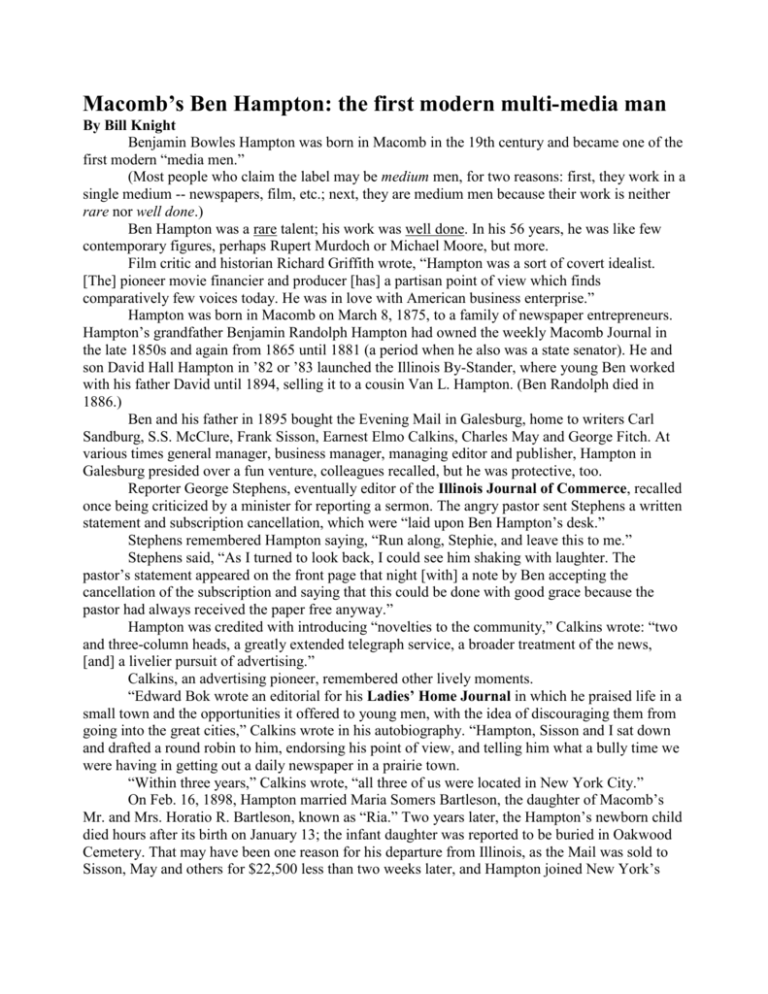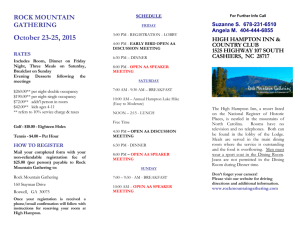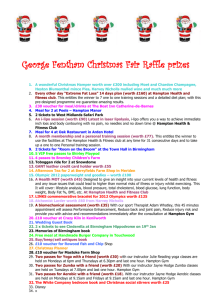Benjamin Hampton
advertisement

Macomb’s Ben Hampton: the first modern multi-media man By Bill Knight Benjamin Bowles Hampton was born in Macomb in the 19th century and became one of the first modern “media men.” (Most people who claim the label may be medium men, for two reasons: first, they work in a single medium -- newspapers, film, etc.; next, they are medium men because their work is neither rare nor well done.) Ben Hampton was a rare talent; his work was well done. In his 56 years, he was like few contemporary figures, perhaps Rupert Murdoch or Michael Moore, but more. Film critic and historian Richard Griffith wrote, “Hampton was a sort of covert idealist. [The] pioneer movie financier and producer [has] a partisan point of view which finds comparatively few voices today. He was in love with American business enterprise.” Hampton was born in Macomb on March 8, 1875, to a family of newspaper entrepreneurs. Hampton’s grandfather Benjamin Randolph Hampton had owned the weekly Macomb Journal in the late 1850s and again from 1865 until 1881 (a period when he also was a state senator). He and son David Hall Hampton in ’82 or ’83 launched the Illinois By-Stander, where young Ben worked with his father David until 1894, selling it to a cousin Van L. Hampton. (Ben Randolph died in 1886.) Ben and his father in 1895 bought the Evening Mail in Galesburg, home to writers Carl Sandburg, S.S. McClure, Frank Sisson, Earnest Elmo Calkins, Charles May and George Fitch. At various times general manager, business manager, managing editor and publisher, Hampton in Galesburg presided over a fun venture, colleagues recalled, but he was protective, too. Reporter George Stephens, eventually editor of the Illinois Journal of Commerce, recalled once being criticized by a minister for reporting a sermon. The angry pastor sent Stephens a written statement and subscription cancellation, which were “laid upon Ben Hampton’s desk.” Stephens remembered Hampton saying, “Run along, Stephie, and leave this to me.” Stephens said, “As I turned to look back, I could see him shaking with laughter. The pastor’s statement appeared on the front page that night [with] a note by Ben accepting the cancellation of the subscription and saying that this could be done with good grace because the pastor had always received the paper free anyway.” Hampton was credited with introducing “novelties to the community,” Calkins wrote: “two and three-column heads, a greatly extended telegraph service, a broader treatment of the news, [and] a livelier pursuit of advertising.” Calkins, an advertising pioneer, remembered other lively moments. “Edward Bok wrote an editorial for his Ladies’ Home Journal in which he praised life in a small town and the opportunities it offered to young men, with the idea of discouraging them from going into the great cities,” Calkins wrote in his autobiography. “Hampton, Sisson and I sat down and drafted a round robin to him, endorsing his point of view, and telling him what a bully time we were having in getting out a daily newspaper in a prairie town. “Within three years,” Calkins wrote, “all three of us were located in New York City.” On Feb. 16, 1898, Hampton married Maria Somers Bartleson, the daughter of Macomb’s Mr. and Mrs. Horatio R. Bartleson, known as “Ria.” Two years later, the Hampton’s newborn child died hours after its birth on January 13; the infant daughter was reported to be buried in Oakwood Cemetery. That may have been one reason for his departure from Illinois, as the Mail was sold to Sisson, May and others for $22,500 less than two weeks later, and Hampton joined New York’s Charles Austin Bates ad agency, where Calkins had become head copy writer. The reason also may have been the promise of new challenges to a man overflowing with ideas and energy. Fitch biographer Martin Litvin wrote about the Hamptons, “Ben ran after advertisers and applied himself to improving his newspaper’s position. They were tireless. Ben especially wanted `the big time’ and to be in New York.” As an ad man, Hampton in 1905 helped the National Cigar Stands expand into Rexall by publishing a 64-page booklet “How to make the Cigar Stand support the Drug Store.” It was as a publisher of a New York-based magazine in the heydays of muckraking journalism that Hampton came to some national prominence. The 5-foot, 10-inch Hampton started rather modestly in 1904, buying Broadway magazine, a 12,000-circulation “feeble magazine,” as reporter Charles Edward Russell (a Davenport native) termed it, at 7 W. 22nd St. Broadway was a 10-cent girlie magazine that “followed the somewhat risqué pattern of near nudity,” according to magazine historian Frank Luther Mott. Hampton was a “genius of an editor,” according to Louis Filler, author of Crusaders for American Liberalism, and soon – staked with $200,000 in savings accumulated in six years in advertising, Hampton and his newly hired editor, Theodore Dreiser, began to change the publication by featuring skilled contributors and new departments. Writers included Rudyard Kipling, O. Henry and P.G. Wodehouse; special pages included “Summer Hostesses of Society” and poetry. It became known as Hampton’s Broadway magazine, then, by 1907, just Hampton’s, selling for 15 cents. The magazine quickly gained respectability, but its influences lagged, Hampton thought. From Dreiser’s perspective, “Hampton had begun to interfere with the editing,” wrote Dreiser biographer Robert H. Elias, “insisting on the purity of stories as against their power, on the popular appeal of articles as against their novelty, and, for the magazine as a whole, on the newly profitable attitude of the muckraker as against the disinterested Dreiserian view of the metropolitan microcosm.” Following such an escalating series of conflicts over editorial decisions and direction, Dreiser in 1907 accepted an offer to edit three Butterick magazines, and Hampton’s started featuring more hard-hitting material, what Russell biographer Robert Miraldi described as “classic muckraking: an effective combination of rhetorical flourishes, dramatic narrative, and facts.” In less than two years, it grew to a circulation of about 480,000. Controlled by Hampton with some editing by socialist Reginald Wright Kaufman, the magazine sought to “expose evil wherever we can; we are going to expose it calmly and truly; we are going to expose it in order that it may be replaced by good.” Even at a time when muckraking magazines flourished, including McClure’s, Pearson’s, Everybody’s, Cosmopolitan, Collier’s, Harper’s Weekly, Ladies’ Home Journal, plus a few smaller publications, Hampton’s became a formidable force for creative writing and investigative reporting. Muckraking was profitable, too. Muckraking publishers included McClure as well as Hampton, and they “resembled their promotion-minded forerunners in daily journalism, like E. W. Scripps (the Rushville native), Joseph Pulitzer and William Randolph Hearst,” wrote Richard Hofstadter in The Age of Reform: From Bryan to F.D.R. Stories that Hampton’s broke ranged from Admiral Robert Peary’s exclusive story of his discovery of the North Pole and well-documented exposes of prisons to sentimental or sensational human-interest pieces. Russell’s articles on the Southern Pacific Railroad helped break its control of California politics. John L. Mathews’ pieces on Richard Ballinger, Secretary of the Interior during the Taft administration, uncovered wrongdoing involving the timber trust in Oregon and Alaska and helped drive him from office (some of it re-packaged as the book, The Vast Riches of Alaska: Will The Morgan-Guggenheim Combination Acquire Them, Or Will They Benefit The Whole People? in 1910). Theodore Bingham’s piece on police corruption in the cities echoed and focused Lincoln Steffens’ “Shame of The Cities” McClure’s series. Peary’s exclusive story of his North Pole exploration was followed not long after by “Dr. [Frederick] Cook’s Own Story” disputing Peary’s version of the polar expedition. Hampton’s had adventure serials and fiction from Jack London and Joseph Conrad. And many articles attacked monopolies and other abuses of power -- the water-power, smelter and sugar trusts -- plus suffrage, women’s employment, and child labor issues, all written by feminist reporter Rheta Childe Dorr, whose collection of magazine stories was published as a 1910 book, What Eight Million Women Want. And Russell again scored mightily with a 1908 article on New York’s wealthy Trinity Episcopal Church corporation, one of the city’s biggest slumlords, when four blocks of its worst tenements had to be demolished. Other contributors included Earl Derr Biggers (“Charlie Chan”), Rex Beach (“The Spoilers”), Gilbert Chesterton and Fitch. Everybody’s magazine publisher John Adams Thayer said, “Hampton possessed unquestioned ability as a publisher. He was one of a number of able young men who obtained their tutelage with Charles Austin Bates, as did Earnest Elmo Calkins.” Meanwhile, muckraking – a term first coined, generally, by Teddy Roosevelt using John Bunyan’s Pilgrim’s Progress imagery at a March 17, 1900, Washington Gridiron dinner but actually popularized concerning journalism by reporter Ellery Sedgwick – began to fade. Asked whether Hampton’s was the only muckraking magazine left in 1910, Hampton replied in the magazine: “Make no mistake. ‘Muck-raking’ has not gone out of date. It really is just beginning to find itself, to make itself efficient ... we know a great deal more about the temper of the American people than the politicians do ... For a while the ‘muck-raking’ was sensational without accomplishing much good ... Nowadays, we know how to get results.” That may have been true, but muckraking publications soon vanished. There were several reasons, observers say: the public grew tired of a continuous stream of exposes; the best writers moved on to other endeavors; the base of support waned with the decline of the Progressive movement; the reporters and publications achieved reforms; or vested interests killed them. By 1916, Era, Harper’s Weekly, Human Life, Ridgeway, Success and Twentieth Century folded. “The greater number of them has been forgotten,” wrote Filler. “Benjamin B. Hampton [was one of] several personages significant to, or central in, muckraking operations, and whose names never appear in commentary respecting the era.” Those vested interests -- frequent targets of muckrakers’ work -- remain. And perhaps there was a long-lasting chilling effect after incidents such as the one that Hampton claimed drove him out of the publishing business. Hampton’s case provides some evidence to support the theory. As part of an occasional series on the great railroads, Russell’s series “The Surrender of New England” investigated the New York, New Haven and Hartford line, and revealed that the company secretly monopolized most of the public transportation in the region, from rail to shipping. But before the article was published, Hampton said, he was visited by a man named Sylvester J. Baxter who claimed to represent the railroad president, Charles Mellon. The agent showed he was familiar with the articles and said that they were false. But when confronted with their accuracy line by line, he retreated and simply threatened retaliation. Hampton refused to pull the article, and in December, 1910, “The Surrender of New England” ran in Hampton’s. Early in 1911, Hampton said, a list of the magazine’s stockholders was stolen from their offices, and the investors were contacted with stories critical of Hampton and his management of their shares of the property. “They said I had a large estate in the Adirondacks and a home in the Fifth Avenue district of New York City,” Hampton told Upton Sinclair. “At that time, Mrs. Hampton and I were having a time to buy clothing for the children. (They lived some 70 miles north of Manhattan in Pawling, N.Y., with five kids: David, Catherine, Helen, Mary and Benjamin R.) We were drawing almost no salary from the magazine, and we had put all our money in the undertaking. In fact, we were near the line of desperation, we were so hard up.” Wall Street brokers began to advertise Hampton’s stock at 80 percent its value – although they had none to sell, Hampton said. When Hampton sought a short-term loan for $30,000 to get the magazine through a slow summer, 21 bankers refused his collateral and credit line of $300,000. Printers unexpectedly demanded advance payment, and Hampton assembled nine people who co-signed loans that he was initially granted, but then was rejected days later by a banker who said he’d been pressured by “downtown” people. “We owed the paper maker, I think, about $40,000 and he notified us arbitrarily on a Monday that we would have to pay the bill Wednesday, or he would decline to furnish paper for the current edition, which was then on the press,” Hampton said. “Within 10 days after the thing began to close in on me, I had to turn my affairs over to the lawyers.” After being rejected by dozens of New York banks -- many controlled by J.P. Morgan -Hampton was forced to sell to new owners, who reportedly drained the magazine of about $175,000 in immediate assets, destroyed its financial records, folded it -- forcing 124,000 investors to lose $2.7 million -- and somehow escaped a federal indictment of criminal mismanagement. “We brought them to trial,” Hampton recalled. “The trial lasted four or five weeks. We literally could not prove anything [except] that Hampton’s was a valuable piece of property. All the records were destroyed. The judge threw the case out of court.” But Hampton had defenders, from Filler and Upton Sinclair to Russell, who in his memoir Bare Hands and Stone Walls wrote, “The public did not wish to have [muckraking] stopped, if circulation figures mean anything. [Hampton’s] was well known to be a popular and expanding enterprise.” The results were that Hampton’s ceased publishing in about a year. “Since Hampton’s was the greatest of the muckraking organs, its shocking end had an indubitable effect on the morale of other organs with like inclinations,” Filler wrote. After Hampton’s was sold and folded, Hampton himself moved on. “Hampton showed his business versatility by becoming a vice-president of the American Tobacco Company, and made a fortune as a moving picture magnate,” Thayer said. While working with American Tobacco’s chief Percival Hill from 1911 to 1916, he discussed the movie business as an investment for Hill and the corporation, then Hampton himself joined the upstart industry. For six years he was an independent movie producer distributed mainly by W.W. Hodkinson in California, where he lived from 1916 to 1930. While there, Hampton produced 10 films, including 1919’s The Westerners starring Roy Stewart, a contemporary of Hoot Gibson and William S. Hart, and 1921’s A Certain Rich Man (based on a novel by fellow small-town journalist William Allen White), directed four, wrote three screenplays, and was “supervisor” of The Dwelling Place of Light (from a novel by Winston Churchill) and “presenter” of The Sagebrusher, starring Noah Beery. Maria died on Jan. 25, 1922, following surgery for appendicitis. And Hampton on Sept. 18, 1924, married actress Claire Adams, who he had under a fiveyear contract, starring in eight of his pictures. [Aside: Adams, born in Canada in 1898, was a Red Cross nurse during World War I and a silent-film actress who appeared in 40-some films with co-stars such as Wallace Beery and Tom Mix, including King Vidor’s The Big Parade with John Gilbert, The Penalty with Lon Chaney, and Where the North Begins with who she called her “favorite heading man,” Rin Tin Tin. After Hampton’s death – which left Adams wealthy – she made just two more films, Combat and What a Mother in Law! (both 1934) and one TV appearance, in the ’60s NBC western Empire, starring Richard Egan, and credited as Peggy Adams. Adams later met Australian rancher and sportsman Donald John Scobie Mackinnon and they wed on April 1, 1937, and after their honeymoon moved to Australia. He died in 1974 and she died in 1978, leaving much of her estate to a hospital, animal-welfare groups and a wildlife sanctuary.] Until Hampton’s death in New York, on Jan. 31, 1932, Hampton often associated with media giants, and was friends with writers Upton Sinclair and Lincoln Steffens, newspaper owner Roy Howard, and ex-judge and social activist Ben Lindsey. And he wrote A History of the Movies, published in 1931 by Covici-Friede (reprinted 39 years later by Arno Press and also by Dover Books, which re-titled it History of The American Film Industry). Hampton said he was encouraged to write his look at early Hollywood by philosopher, psychologist, and education reformer John Dewey, and the writing and re-writing took five years. Hampton had great hopes for the film industry, which he saw as “the one triumph of democracy in creating an effective agency of its very own. “The telegraph, the telephone, the electric light ... had created a sensation, but they had not entered into the lives of millions of people,” he wrote. “The common man and his family still used kerosene lamps; none but the well-to-do had telephones, and the telegram was a form of communication seldom known in the average household except to announce serious illness or death. But this new thing – this ‘living picture’ affair – was not a prosaic tool to reduce labor or to save time; it was not an instrument to create more comfort and luxury for the well-to-do. It was a romantic device to bring entertainment to the common people.” Filler echoed such an assessment of Hampton’s own connection with everyday Americans. “So long as there was muck, there had to be muckraking: It was a necessary agency in American life,” Filler wrote. “So long as its spirit endured, Hampton [once] declared, democracy as it was understood by Americans would prevail.” And publishers profited. Historian Griffith wrote that Hampton “subscribed to the doctrine that the public is to be served, that money is to be made in its service, and that you will make lots of money if you serve it quicker and better than the man who is breathing down your neck.” With roots in the rural Midwest, this energetic idea man had enough of a devotion to the grass-roots population, a powerful work ethic, ambitions and original ideas to make it to the big time in media. Many media. Works Cited Walter Brasch, Forerunners of Revolution, University Press of America, Lanham, Md., 1990. Earnest Elmo Calkins, They Broke the Prairie, Scribner’s, New York, 1937. Robert Cantwell, "Muckraking As Literature," The Muckrakers and American Society, Herbert Shapiro, ed., D.C. Heath, Boston, 1968. “Capnevall,” Good Health to all from Rexall, http://capnrexall.blogspot.com/ R.A. Church and Andrew Godley, The Emergence of Modern Marketing, Routledge, London/New York, 2003. John Hampton Dean, Hampton History: An Account of the Pennsylvania Hamptons in America In the Line of John Hampton, Jr., of Wrightstown, published by Dr. Solomon E. Hampton, Milton, Ky., 1911 Theodore Dreiser, Twelve Men, Boni & Liveright, New York, 1919. Robert H. Elias, Theodore Dreiser, Knopf, New York, 1949. Richard Fidczuk, The FictionMags index, www.philsp.com/homeville/fmi/t1694.htm Louis Filler, Crusaders for American Liberalism, Harcourt, Brace & Co., New York, 1939. Robert Goldberg and Gerald Jay Goldberg, Citizen Turner: The Wild Rise of an American Tycoon, Harcourt Brace, New York, 1995. John Hallwas, "Macomb Journal history spans more than a century," Macomb Daily Journal, June 29, 1982. Benjamin Bowles Hampton, History of the American Film Industry, from Its Beginnings to 1931, Dover Publications, New York, 1970. Richard Hofstadter, The Age of Reform, Knopf, New York, 1955. Internet Movie database/ IMDb.com Library of Congress, Prints & Photographs Online Catalog Martin Litvin, I'm Going to be Somebody!, Western Books, Woodston, Kan., 1992. Michael D. Marcaccio, "Did a Business Conspiracy End Muckraking? A Reexamination," The Historian 47 (1984). Robert Miraldi, The Pen is Mightier, Palgrave/Macmillan, New York, 2003. Frank Luther Mott, A History of American Magazines, Harvard University Press, Cambridge, Mass., 1968. Donald Paneth, Encyclopedia of American Journalism, Facts On File, New York, 1983. Abe Ravitz, David Graham Phillips, Twayne, New York, 1966. Charles Edward Russell, Bare Hands and Stone Walls, Scribner's, New York, 1933. John Simkin, Benjamin Hampton, http://spartacus-educational.com/USAhampton.htm Upton Sinclair, The Brass Check, Bonibooks, New York, 1936. Francis H. Sisson, “Reporting for The Evening Mail,” George Fitch: A Memorial, Knox College, Galesburg, Ill., 1918. M.L. Stein, "Where Have All The Muckrakers Gone?", Editor & Publisher, April 15, 1995. W.A. Swanberg, Dreiser, Scribner's, New York, 1965. John Adams Thayer, “Some Shocks and Thrills in Publishing,” Advertising & Selling, circa 1923 Marla Vizdal, Macomb Public Library: Census and related data via Ancestry.com Arthur and Lila Weinberg, The Muckrakers, Simon and Schuster, New York, 1961. ___, Hearst Newspaper Collection, University of Southern California Library, Los Angeles, Calif. ___, Macomb Journal, Genealogical abstracts, 1898-1900. ___, "B.B. Hampton dies; a former editor," New York Times, Feb. 1, 1932. ___, Thirty-fifth birthday edition, Galesburg Register Mail, Feb. 14, 1927.






